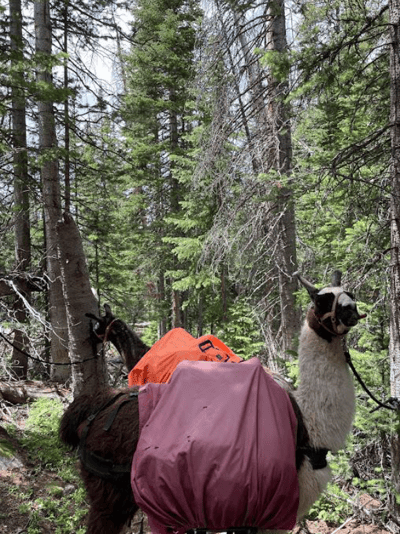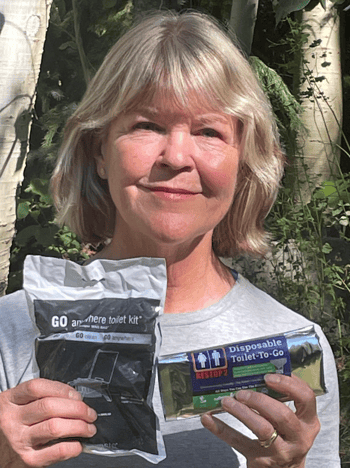The urge to leave one’s mark on the world may be a uniquely human trait. But this month on September 17, National CleanUp Day and World Cleanup Day, events like the Eagle River Watershed Council’s annual Highway Clean up and Eagle River Cleanup, remind us that there are some marks we don’t want to leave behind when out in nature – our waste.
Being a steward and cleaning up after ourselves should not be limited to dedicated CleanUp Days, but should happen daily both in our normal lives and in the backcountry. Fall is one of the best times to backpack and hike in our local Wilderness Areas. Warm, sunny days and cool nights beckon us into the backcountry. Aspens, grasses, and brush turn golden, orange, red, and purple as chlorophyll production slows, painting the perfect backdrop for our outings.

What better time to refresh how to minimize our footprint when accessing our public lands. The 7 Leave No Trace, or LNT, Principles are a great place to start. An easy way to memorize the 7 LNT Principles are the 7 Fs. Fs may not be so great when it comes to school grades, but they provide a fun way to remember LNT when hiking and camping. The 7 Fs are Future, Footing, Filth, Flora, Fire, Fauna, Friends.
“Future” reminds us of the LNT Principle, plan ahead and prepare. Failure to plan your route and prepare for a safe trip can lead to resource damage, including off-trail travel and the need for rescue. Learn the regulations on camping, including required distance from lakes and streams.
“Footing” - Remember to stay on trail and camp on durable surfaces that won’t show your impact. Hiking off-trail causes erosion, stresses wildlife and delicate alpine plants, and spreads invasive weeds that outcompete our native plants.
“Filth” - Dispose of waste properly. If you carried it in, carry it out. Each summer, the Eagle Summit Wilderness Alliance leads llama-supported trips into local wilderness lakes to remove trash and illegal campfire rings left by backpackers and hunters.
 Llama-supported trips to remove trash
Llama-supported trips to remove trash
“Flora” – Leave what you find. Take only pictures.
“Fire” – Campfires are tough on our alpine environment. They scar the landscape and can cause forest fires. Gathering wood is harmful. Our high-alpine forests fight for survival in a challenging environment, and trees need their live branches. Fallen branches provide hiding places for wildlife, harbor plants, and become future soil. So, use a lightweight cook stove.
“Fauna” – Respect wildlife by keeping your distance and storing food and food waste in a bear-proof container. Keep dogs on leash – wildlife views dogs as predators, and dog-wildlife encounters often end up poorly for pets, wildlife, and owners. Where permitted off leash, keep your dog on-trail and at no more than leash length, including while camping.
“Friends” – Be considerate of others. Not everyone wants to hear your music on the trail or wafting across a lake, or be visited by your enthusiastic puppy. Noisy neighbors, uncontrolled dogs, and damaged surroundings detract from the wilderness experience.
Let’s take a moment to get personal about disposal of a certain type of waste - human and canine feces. Unlike wildlife feces, they contain contaminants that can sicken wildlife, spread disease, and cause invasive plants to outcompete delicate natives. The old technique of burying feces 6-8 inches deep just isn’t feasible in our thin high-alpine soils and more-popular areas.

Author, Frances Hartogh, demonstrates two types of WAG Bags hikers should use when in the backcountry.
What to “doo”? WAG bags to the rescue! WAG (Waste Alleviation and Gelling) bags contain a gelling powder designed by NASA to absorb odors. Puncture-resistant and double-layered to avoid leaks, WAG bags are good for 3-4 uses, and disposable in any garbage can.
Here in Eagle County, we’re privileged to have the Eagles Nest and Holy Cross Wilderness at our doorsteps, “an area where the earth and its community of life are untrammeled by man, where man himself is a visitor who does not remain.” (Wilderness Act of 1964) So, the next time you head out into the wilderness, be equipped to leave no trace.
Frances Hartogh is a Volunteer Wilderness Ranger and Sawyer for ESWA, the Eagle Summit Wilderness Alliance, an all-volunteer nonprofit that helps the Forest Service preserve and protect the Wilderness Areas in Eagle and Summit counties.








